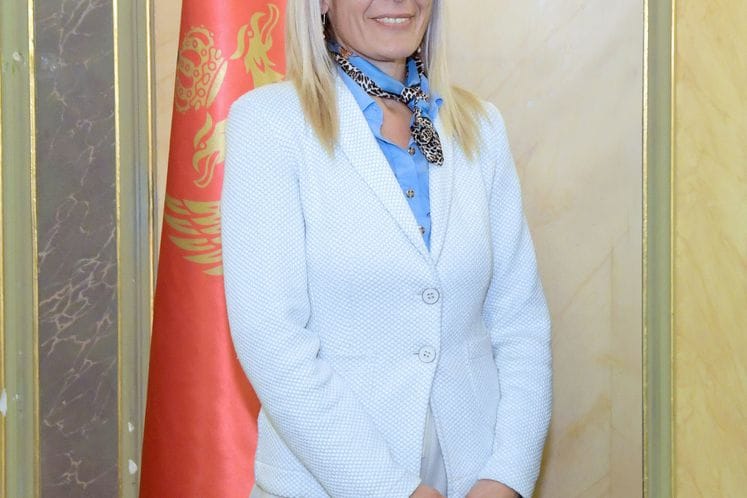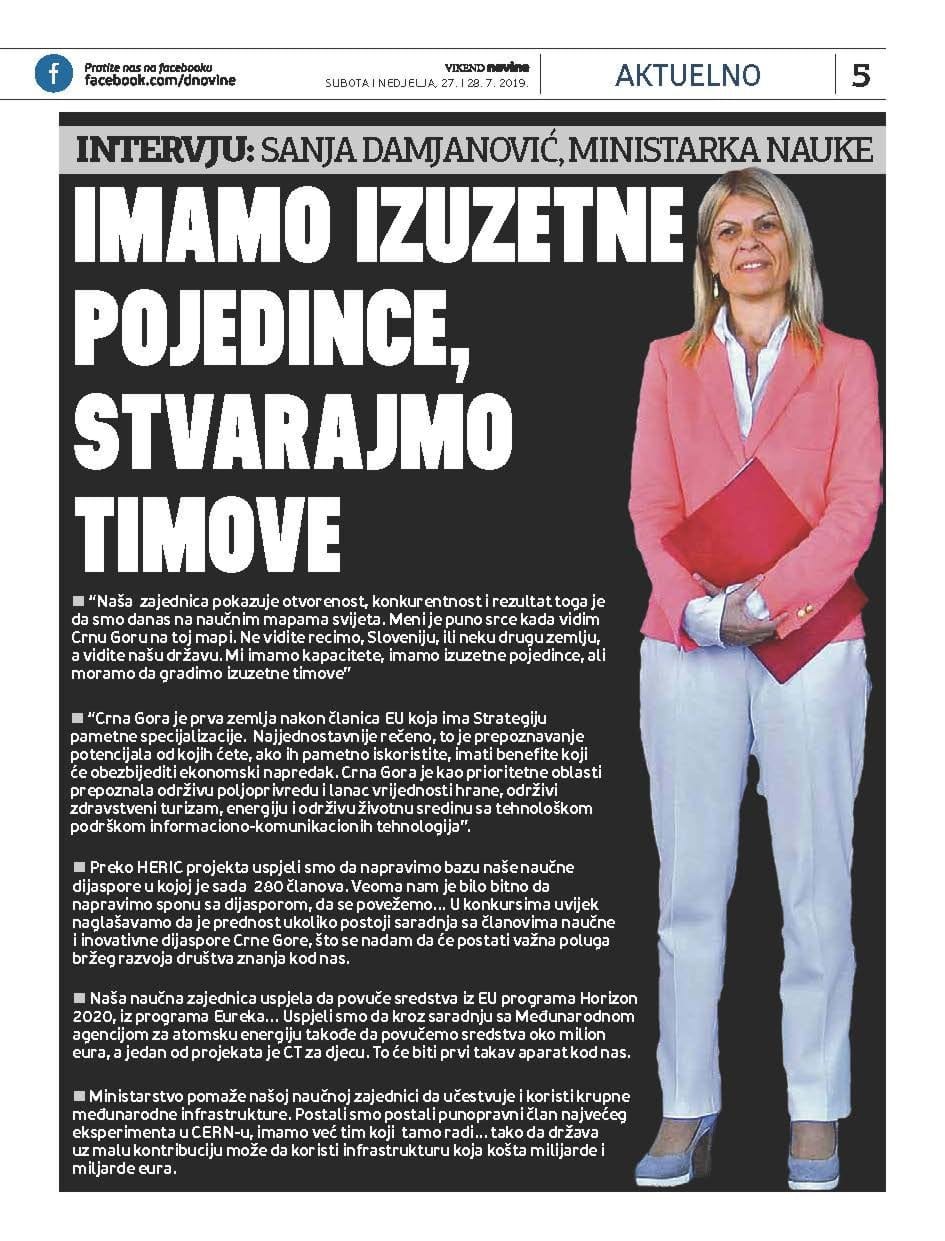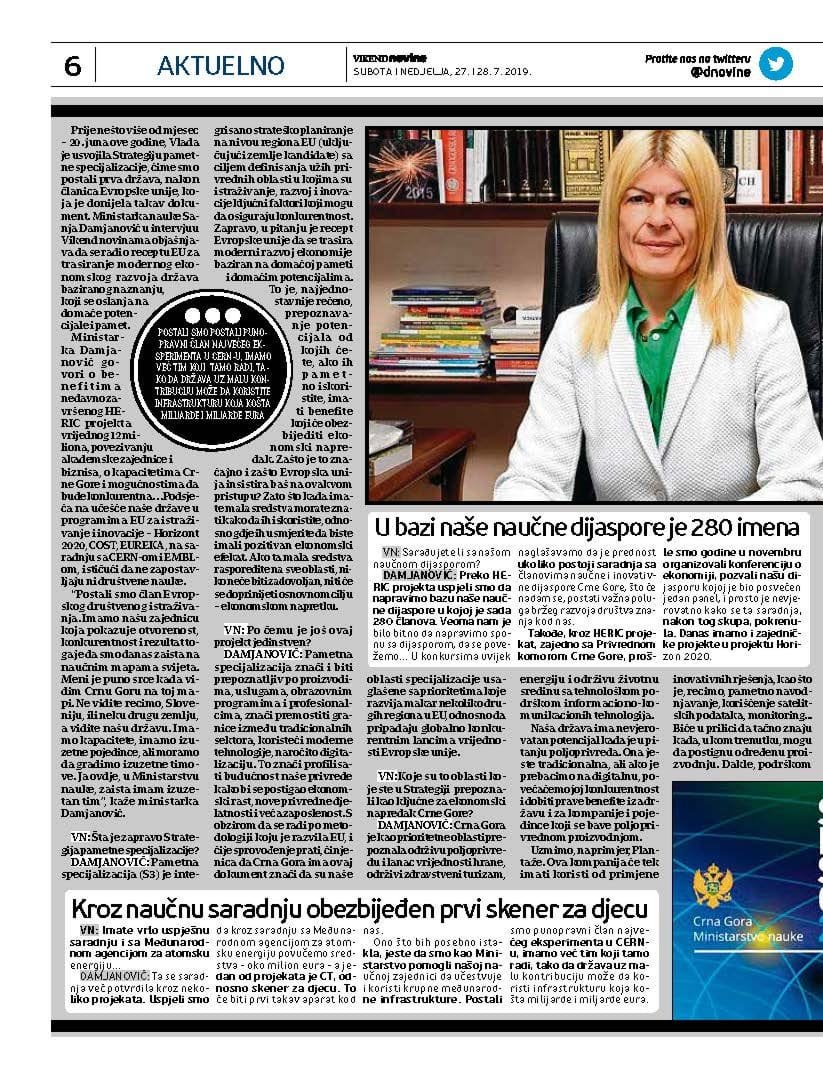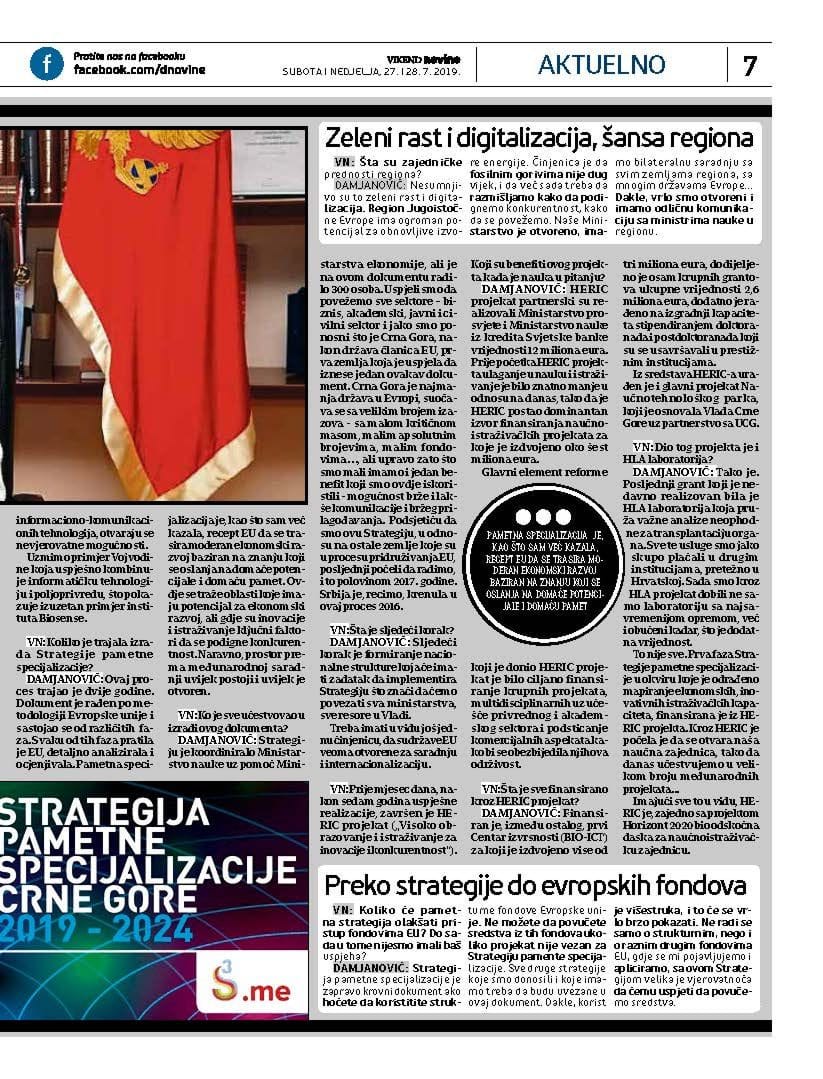- Government of Montenegro
Ministry of Education, Science and Innovation INTERVIEW: SANJA DAMJANOVIĆ, MINISTER OF SCIENCE
INTERVIEW: SANJA DAMJANOVIĆ, MINISTER OF SCIENCE


INTERVIEW: SANJA DAMJANOVIĆ, MINISTER OF SCIENCE IS AVAILABLE HERE:
» We have exceptional individuals, let’s create teams.pdf
» There are 280 individuals in our scientific diaspora database.pdf
WE HAVE EXCEPTIONAL INDIVIDUALS, LET’S CREATE TEAMS
Just over a month ago – on 20 June this year, the Government of Montenegro adopted the Smart Specialisation Strategy, making us the first non-EU country to adopt such a policy document. In an interview for Vikend novine, Minister of Science Sanja Damjanović explains that S3 is an EU recipe for paving the road to modern knowledge-based economic development that relies on domestic potential and intelligence of a country.
Minister Damjanović speaks about the benefits of the recently completed HERIC project (worth a total of EUR 12 million), connections between the academic community and the business sector, the capacities of Montenegro and its potential to be competitive, etc. Furthermore, Damjanović reflects on our country’s participation in EU research and innovation programmes – Horizon 2020, COST, EUREKA, as well as on cooperation with CERN and EMBL, indicating that social sciences receive equal attention of the Ministry.
“We have become a member of the European Social Survey. We have our community that shows openness and competitiveness – as a result, we truly form part of the scientific maps of the world today. I am delighted to see Montenegro on that map. You don’t see, for example, Slovenia, or other countries, but you see our country. We have the capacity and exceptional individuals, but we have to build exceptional teams as well. Here at the Ministry of Science, I have an exceptional team”, Minister Damjanović says.
VN: What exactly is the Smart Specialisation Strategy?
DAMJANOVIĆ: Smart specialisation (S3) is integrated strategic planning at the level of EU regions (including candidate countries), which aims to define specific economic areas in which research, development and innovation are key factors that can ensure competitiveness. In fact, it is a recipe of the European Union for paving the road to modern economic development based on domestic intelligence and potential.
The concept, to put it simply, implies the identification of potentials that will, if used wisely, produce benefits providing for economic progress. Why is this important and why does the European Union insist on this approach? Because in a situation where you have limited resources you need to know how to use them, i.e. where to direct them, to have a positive economic effect. If you allocate these limited resources to all areas, no one will be satisfied and no contribution will be made to the basic goal of economic progress.
VN: What else makes this project unique?
DAMJANOVIĆ: Smart specialisation means being recognised by products, services, educational programmes and professionals, as well as bridging the boundaries between traditional sectors by using modern technologies, especially digitalisation. It also implies profiling the future of our economy with a view to achieve economic growth, new economic activities and higher employment. Given that the S3 methodology was developed by the EU, and that the document’s implementation is monitored by the EU, the fact that Montenegro has prepared this document means that our areas of specialisation are in line with the priorities developed by at least several other EU regions. In other words, they belong to globally competitive European Union value chains.
VN: What are the areas you identified in the Strategy as crucial to Montenegro’s economic progress?
DAMJANOVIĆ: The priority areas identified by the Strategy are sustainable agriculture and food value chain, sustainable health tourism, energy and sustainable environment, and information and communication technologies – as technological support.
Our country has incredible potential in the field of agriculture. It is traditional now, but if we transform it to digital, we will increase its competitiveness and get real benefits for the country itself, as well as for the companies and individuals engaged in agricultural production.
Take Plantaže company, for example. This company is yet to benefit from the implementation of innovative solutions such as, for example, smart irrigation, the use of satellite data, monitoring... They will be able to know exactly when, at what point, they can achieve certain production. Therefore, through the support of information and communication technologies, incredible opportunities open up.
We can also mention the example of Vojvodina, which successfully combines information technology and agriculture, as demonstrated by the remarkable example of the BioSense Institute.
VN: How long did it take to develop the Smart Specialisation Strategy?
DAMJANOVIĆ: The process took two years. The document was developed on the basis of the methodology of the European Union and included different stages. Each of these stages was thoroughly monitored, analysed and evaluated by the EU. Smart specialisation is, as I already indicated, a tool for the EU to pursue modern knowledge-based economic development that relies on domestic potentials and intelligence. The intention here is to identify areas with potential for economic development, where innovation and research are key factors to improve competitiveness. Of course, there is always room for international cooperation.
VN: Who participated in the development of this document?
DAMJANOVIĆ: The S3 drafting process was coordinated by the Ministry of Science, with the assistance of the Ministry of Economy, but 300 people worked on this document in total. We have managed to connect all sectors – business, academic, public and civil – and are very proud that Montenegro is the first non-EU country to produce such a policy document. Montenegro is the smallest country in Europe, facing a lot of challenges – small critical mass, small absolute numbers, small funds… but it is precisely because of our size that we also have a benefit that we have utilised here – the possibility of faster and easier communication and faster adjustments.
I will remind you that, in relation to the other countries in the process of joining the EU, we were the last ones to start working on the Strategy (in mid-2017). Serbia, for example, has initiated the process in 2016.
VN: What is the next step now?
DAMJANOVIĆ: The next step is to establish a national structure that will be tasked with implementation of the Strategy, which means that we will connect all ministries, all departments in the Government. Another fact to bear in mind here is that EU countries are very open to cooperation and internationalisation.
VN: A month ago, after seven years of successful implementation, the HERIC project (Higher Education and Research for Innovation and Competitiveness) was completed. What are the benefits of this project in the field of science?
DAMJANOVIĆ: The HERIC project was implemented in partnership by the Ministry of Education and the Ministry of Science, with funds provided through a World Bank loan worth EUR 12 million. Before the start of the project, investment in science and research was much smaller than it is today, so HERIC project became the dominant source of financing for scientific research projects, for which around six million euros were allocated.
The main reform element brought by the HERIC project was the targeted financing of large-scale multidisciplinary projects, with the participation of the economic and the academic sector and the promotion of their commercial aspects to ensure their sustainability.
VN: What was financed through the HERIC project?
DAMJANOVIĆ: Inter alia, the first Centre of Excellence (BIO-ICT), for which more than three million euros were allocated. Furthermore, eight large grants worth a total of EUR 2.6 million were awarded, with further efforts taken towards capacity-building through scholarships to doctoral and postdoctoral students enrolled in education programmes in renowned institutions.
The final design of the Science and Technology Park, established by the Government of Montenegro in partnership with the University of Montenegro, was also developed thanks to HERIC funds.
VN: HLA laboratory is also a part of that project?
DAMJANOVIĆ: That is correct. The last grant implemented recently was the HLA laboratory, which provides important analyses necessary for organ transplantation. So far, we have been paying for all these very costly services to other institutions, mainly from Croatia. Now, through the HLA project, we have provided not only a laboratory with state-of-the-art equipment, but also trained staff, which is an added value.
That is not all, however. The first stage of the Smart Specialisation Strategy, in which the mapping of economic, research and innovation capacities was done, was funded through the HERIC project. In addition, it was through HERIC project that our scientific community has begun to open, so today we take part in a large number of international projects...
Given all of the above, the HERIC project has, along with Horizon 2020, given a real boost to the scientific research community of Montenegro.
GREEN GROWTH AND DIGITALISATION, A CHANCE FOR THE REGION
VN: What are the common advantages of the region?
DAMJANOVIĆ: Undoubtedly, these are green growth and digitalisation. The South-East Europe region has huge potential in renewable energy sources. The fact is that fossil fuels will not last forever and that we should already be thinking about how to increase competitiveness, how to connect. Our Ministry is open – we have bilateral cooperation with all countries in the region, with many countries in Europe… We are very open and have excellent communication with the ministers of science in the region.


